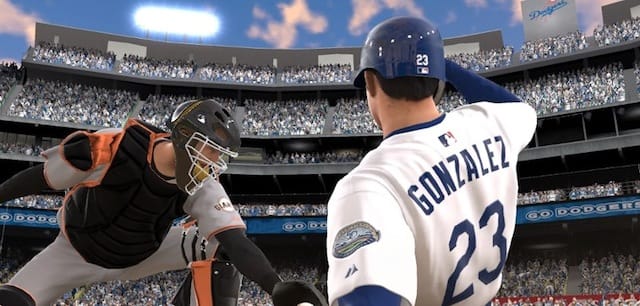How MLB: The Show tricked me into hating my favorite team

As I watch the Los Angeles Dodgers – my favorite baseball team – prepare to give up the ghost on an improbable pennant race this week, I’m fighting a disconcerting feeling: smug satisfaction.
Things used to be simple. Like most baseball fans, I had hedged myself with two teams: the winners and the losers. I grew up watching the Yankees and so part of me will always love those roided-out, over-paid, most-winningest bullies. To compensate, I used to follow the Indians, a rugged small-market team that never made it to the playoffs and who were constantly being forced to auction off their best prospects. Then MLB the Show ruined everything. Let me explain.
What I needed was a team that was objectively pretty bad in the real world but that harbored some exceptional, if hidden, talents in the game– half underdog, half hustler.
When I started playing the Show seriously, I realized neither of my real-world favorites would do. The Yankees were obviously too good–ranked first or second in every category, the equivalent of playing with a Game Genie. And the Indians were just awful: slow, weak, error- and injury-prone. What I needed was a team that was objectively pretty bad in the real world but that harbored some exceptional, if hidden, talents in the game– half underdog, half hustler.
For all its effectiveness as a simulation, the Show has certain unrealistic biases, especially in online play. First, there is an issue with lag, which tends to exaggerate the speed of good runners while minimizing the effectiveness of good fielders. There is also the game’s general tendency to under-reward power hitting and over-reward power pitching. So I knew the team I needed would have fast runners, one exceptional starting pitcher (online games are not part of a continuous season, so you can use the same starter every time), and that I could do without the sluggers or Gold Gloves.

Enter the Los Angeles Dodgers. In 2009, I discovered that the disconnect between their real-life performance and their narrow Show-centric skill sets meant that they were the ultimate secret weapon. They had very good speed on the bases and a devastatingly effective starter in Clayton Kershaw, whose borderline glitch wind-up and 30mph pitch differential made him the closest thing to a Boss Stage that you are going to find in a sports video game.
They also hit and fielded like a little league team. Big deal. The game calculates a team’s overall rank through a mysterious formula that does a very good job of predicting their real world chances, but does a terrible job of predicting how a team plays in the game. For the better part of the past three seasons, the Show ranked the Dodgers in the bottom third, and the real Dodgers obliged, sagging in the middle of the weakest division in baseball. Meanwhile, I used them to post online winning records in the high .700s.
I didn’t just tolerate the real Dodger’s shortcomings, I reveled in them.
So began my journey-in-reverse to becoming a die-hard Dodger fan. Most people favor a virtual squad out of their commitment to their real-life counterparts; for me, the real Dodgers were only interesting because they resembled the team I had spent countless hours controlling in the Show. Before I ever watched a real Dodger game, I knew every signature stance, every pitch every one of their relievers could throw. I knew the third base coach’s jersey number. Sports fandom and competitive gaming both converge in the obsession over pointless details; who cared which side I had started on. In fact, the Show had set me up unusually well for the necessary, paradoxical skill of enjoying a bad team’s flaws; I didn’t just tolerate the real Dodger’s shortcomings, I reveled in them.
Then this summer, something awful happened. For the first time since I had become a Dodgers fan, the real Dodgers got good.
By mid-August, they stood a couple games back of the pennant and half a game away from a wild-card slot. And then the owners went all-in for a championship bid, sinking 250 million for three all-star upgrades from the Red Sox–the largest post-deadline trade in baseball history.
For the first time in years, the Dodgers were objectively stacked. When the Show’s requisite online roster update popped up a few days later I already knew it was all over. The virtual Dodgers diamond had come out of the rough. They were now painfully, obviously good; virtual Yankees good. I tried playing as the new Dodgers and easily beat the beastly Texas Rangers 8-0. It was like an inverse World Series Game 7: I had won so egregiously, I knew that my endless Dodgers season was finally over.

Meanwhile, the real, post-trade Dodgers had begun a late-season meltdown. They slipped ten games back of the pennant, and as of this writing are an impossible 3 games out of the wild-card with 6 left to play.
And so here I am, the victim of this bizarre bait-and-switch: a video game coaxed me into liking a real team because they were good-bad and now the real world has stuck me with a bunch of bad-good video game bums. The exiled gamer in me is glad the real Dodgers are suffering; the converted virtual fan in me wants to see them make a miraculous turn-around.
Either way, I’ve given up on the Dodgers this year, real and virtual. I’m already looking ahead to 2013, hoping they can make good use of the off-season. Deal away their talent in some awful trades, endure some career-ending injuries, skimp on the fundamentals. Whatever. Just as long as they come out of the gates next year ready to be the right type of wrong.



